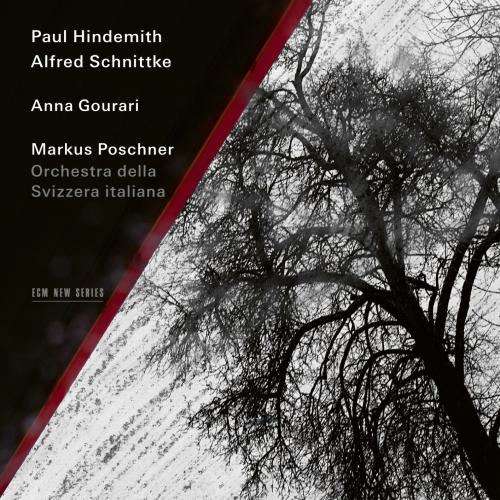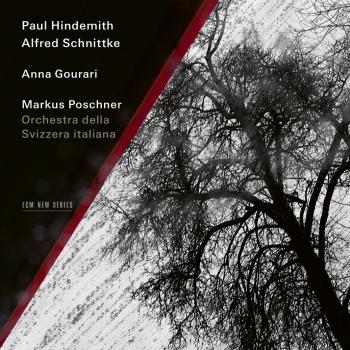
Paul Hindemith – Alfred Schnittke Anna Gourari, Orchestra della Svizzera italiana & Markus Poschner
Album info
Album-Release:
2024
HRA-Release:
14.06.2024
Label: ECM New Series
Genre: Classical
Subgenre: Concertos
Artist: Anna Gourari, Orchestra della Svizzera italiana & Markus Poschner
Composer: Paul Hindemith (1895-1963), Alfred Schnittke (1934-1998)
Album including Album cover Booklet (PDF)
I`m sorry!
Dear HIGHRESAUDIO Visitor,
due to territorial constraints and also different releases dates in each country you currently can`t purchase this album. We are updating our release dates twice a week. So, please feel free to check from time-to-time, if the album is available for your country.
We suggest, that you bookmark the album and use our Short List function.
Thank you for your understanding and patience.
Yours sincerely, HIGHRESAUDIO
- Alfred Schnittke (1934 - 1998): Concerto for Piano and String Orchestra:
- 1 Schnittke: Concerto for Piano and String Orchestra 23:12
- Paul Hindemith (1895 - 1963): Mathis der Maler Symphony:
- 2 Hindemith: Mathis der Maler Symphony: I. Engelkonzert 08:43
- 3 Hindemith: Mathis der Maler Symphony: II. Grablegung 04:26
- 4 Hindemith: Mathis der Maler Symphony: III. Versuchung des heiligen Antonius 13:57
- The Four Temperaments for Piano and String Orchestra:
- 5 Hindemith: The Four Temperaments for Piano and String Orchestra: Thema. Moderato 06:06
- 6 Hindemith: The Four Temperaments for Piano and String Orchestra: Var. 1. Melancholisch. Langsam 06:16
- 7 Hindemith: The Four Temperaments for Piano and String Orchestra: Var. 2. Sanguinisch. Walzer 05:53
- 8 Hindemith: The Four Temperaments for Piano and String Orchestra: Var. 3. Phlegmatisch. Moderato 04:40
- 9 Hindemith: The Four Temperaments for Piano and String Orchestra: Var. 4. Cholerisch. Vivace 06:38
Info for Paul Hindemith – Alfred Schnittke
In a programme that combines Alfred Schnittke’s Concert for piano and string orchestra with Paul Hindemith’s Symphony Mathis der Maler and the composer’s The Four Temperaments, pianist Anna Gourari together with the Lugano-based Orchestra della Svizzera italiana under Markus Poschner shines in powerful performances that dress these idiosyncratic and contrasting works in beaming colours. The recording, captured at the Auditorio Stelio Molo – abound with sonic detail –, undergirds both the counterpuntal fabric of Hindemith’s neoclassical leaning repertory, and the polystilistic maze of Schnittke’s Concerto, where, according to the composer himself “everything – unable to create the balance between ‘sunshine’ and ‘storm clouds’ – shatters finally into a thousand pieces”.
“The individuality of an artist is shown by the fact that one is courageous and open to foreign influences. Then all that arrives from outside becomes your own.” What may sound like a casual observation of Schnittke’s, in actuality represents the German-Russian composer’s arguably most important guiding principle in regard to his compositional approach. Rather than compulsively trying to reinvent the wheel, Schnittke, as Roman Brotbeck puts it in his liner note, “understood his composing solely as an act of perception”: “I don’t see my mission in making up and creating music,” Schnittke said, “but rather listening to it. It’s about not disturbing my ear when listening to what’s happening outside of me.”
Flourished with quotes and references, borrowed as much from music’s history as from the composer’s everyday-life (one motif corresponds to the doorbell of his Moscow apartment at the time), Schnittke’s Concert for piano and string orchestra unfolds like a storm, dissonant passages of stark chromaticism interlaced with outbursts of rumbling rhythms, crescendoeing in exuberant classical cadences of traditional harmonic design. The composer chose playful images to describe different parts of his piece, speaking of “surrealistic shreds of sunrise from orthodox church music” as well as “a false burst of Prokofievian energy” and “a blues nightmare”. The interpretation here brims with dynamic nuance, bringing out the adventurous score’s rich potential.
The Hindemith share of the album begins without piano, presenting the orchestra in a compelling performance of the Symphony Mathis der Maler. Based on three parts of the Isenheim Altarpiece, sculpted and painted by the Germans Nikolaus von Hagenau and Matthias Grünewald, Hindemith thoughtfully translated Grünewald’s pictorial language into music. The composer would later integrate the symphony into the opera Mathis der Maler, premièred in 1938, where the symphony’s first movement, Engelkonzert, – though structured as a traditional sonata form – became the overture.
Thematically hinged on a late medieval song, the first movement bears contours of music far earlier than the 20th century, but viewed through the transfiguring modern perspective of the composer who redefined “free tonality” on the basis of relations within the chromatic scale, as elaborated upon in his detailed 1941 treatise “The Craft Of Musical Composition”. The contemplative second movement Grablegung and expansive third movement Versuchung des heiligen Antonius persist with intricate thematic development, brought forth by a confident orchestral display.
Anna Gourari returns for the closing work, Hindemith’s The Four Temperments. Originally conceived as a ballet for Léonide Massine, Hindemith – just recently exiled in the US – ultimately completed the score as a commission for George Balanchine, basing it on the Greek theory of temperaments, while its formal conception is a theme with four variations. “The piano appears in all parts,” Roman Brotbeck remarks in the liner notes. “Sometimes as a virtuoso soloist, sometimes as an obbligato accompanist or rhythmically propelling. In this recording, soloist Anna Gourari slips into the various roles like a chameleon and, together with conductor Markus Poschner, unleashes a fantastically surreal dance.”
Recorded in Lugano’s Auditorio Stelio Molo, in December 2021, the album was produced by Manfred Eicher.
Anna Gourari, piano
Orchestra della Svizzera italiana
Markus Poschner, conductor
Anna Gourari
The marvel of Gourari’s playing is the combination of intuitive pacing, propulsive phrasing and rhythmic inflection that makes music spring to life with explosive power. The melding of physicality and thoughtfulness arises again and again – every note has a purpose. – Fanfare
Anna Gourari was born in Kazan (Republic of Tatarstan) and has been based in Germany since 1990. A musician steeped in the venerable Russian piano school, the pianist had already garnered many accolades, including winning the Clara Schumann piano competition in 1994 (with Martha Argerich, Vladmir Ashkenazy, Nelson Freire i.a. in the jury), and released a number of recordings for Decca, Edel and Koch Classics before she made her ECM debut with 2012’s Canto Oscuro – a set of “dark songs” with music by Bach, Hindemith and Sofia Gubaidulina. Further recordings followed with 2014’s Visions Fugitives and Elusive Affinity from 2019, spanning works from multiple centuries, including music by Giya Kancheli, Arvo Pärt, Alfred Schnittke, Prokofiev, Medtner, Chopin etc. Anna is a revered international performer of both chamber music and as a soloist and has collaborated with conductors Sir Colin Davis, Iván Fischer, Lorin Maazel, Kirill Petrenko and many more. Composers Rodion Shchedrin and Jörg Widmann have written and dedicated compositions to her.
Booklet for Paul Hindemith – Alfred Schnittke










